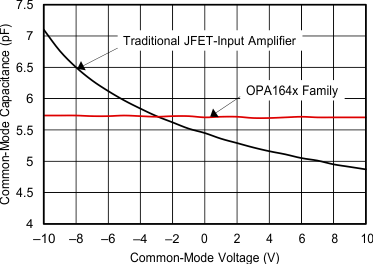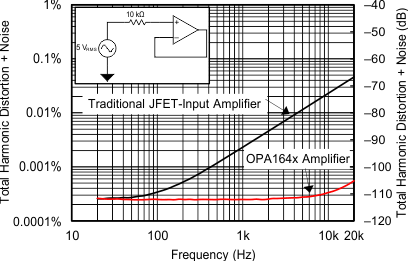ZHCSGB7A June 2017 – November 2017 OPA1641-Q1 , OPA1642-Q1
PRODUCTION DATA.
8.1.2 Source Impedance and Distortion
In traditional JFET-input op amps, the impedance applied to the positive and negative inputs in noninverting applications must be matched for lowest distortion. Legacy methods for fabricating the JFETs in the FET input stage exhibit a varying input capacitance with applied common-mode input voltage. In inverting configurations, the input does not vary with input voltage because the inverting input is held at virtual ground. However, in noninverting applications, the inputs do vary, and the gate-to-source voltage is not constant. This effect produces increased distortion resulting from the varying capacitance for unmatched source impedances. However, the OPA164x-Q1 family of amplifiers is designed to maintain a constant input capacitance with varying common-mode voltage to prevent this mechanism of distortion. The variation of input capacitance with common-mode voltage for a traditional amplifier is compared to the OPA164x-Q1 family in Figure 34.
 Figure 34. Input Capacitance of the OPA164x-Q1 Family of Amplifiers Compared to Traditional JFET-input Amplifiers
Figure 34. Input Capacitance of the OPA164x-Q1 Family of Amplifiers Compared to Traditional JFET-input AmplifiersBy stabilizing the input capacitance, the distortion performance of the amplifier is greatly improved for noninverting configurations with high source impedances. The measured performance of an OPA164x-Q1 amplifier is compared to a traditional JFET-input amplifier in Figure 35. The unity-gain configuration, high source impedance, and large-signal amplitude produce additional distortion in the traditional amplifier.
 Figure 35. Measured THD+N of the OPA164x-Q1 Family of Amplifiers Compared to Traditional JFET-input Amplifiers
Figure 35. Measured THD+N of the OPA164x-Q1 Family of Amplifiers Compared to Traditional JFET-input Amplifiers